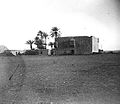Al Qatraneh or Al Qatrana اﻟﻘﻄﺮاﻧﺔ | |
|---|---|
Town | |
| Coordinates: 31°15′13″N36°02′50″E / 31.25361°N 36.04722°E | |
| Country | |
| Governorate | Karak Governorate |
| Government | |
| • Type | Municipality |
| • Mayor | Faisal Alasfar |
| Population (2015) [1] | |
• Total | 7,070 |
| Time zone | UTC+2 (UTC+2) |
| • Summer (DST) | UTC+3 (UTC+3) |
| Area code | +(962)3 |
Al Qatraneh or Al Qatrana is a small town in Jordan. [2] It is located 90 miles south of Amman. [2] [3] It belongs administratively to Karak Governorate.


